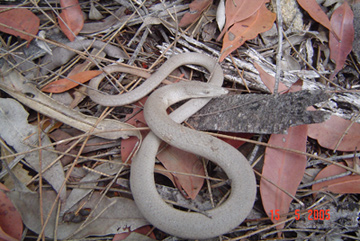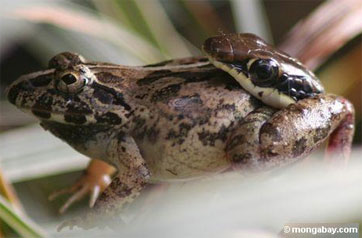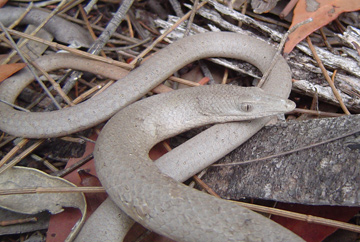Legless lizard retracts eyes to avoid retaliatory prey bites
Legless lizard retracts eyes to avoid retaliatory prey bites
Rhett A. Butler, mongabay.com
August 14, 2007 [Updated Aug 20]
Legless hunters have devised strategies for avoiding defensive bites from prey.
For creatures without legs, snakes are remarkable predators. Pythons can capture and eat animals well over twice their size, while a mere drop of venom injected by an Australian death adder can kill a person. Scientists believe the main purpose for these adaptations is to help snakes avoid injury when pursuing and eating prey.
However, snakes are not the only legless reptiles — there are more than a dozen species of legless lizard distributed around the world. A new paper examines how these reptiles subdue their prey without venom or constriction.
Studying Burton’s legless lizard (Lialis burtonis) from northern Australia, biologists Michael Wall and Richard Shine from the University of Sydney found that the lizards “modified their strike precision according to prey size; very large prey were always struck on the head or neck, preventing them from biting.”

L. burtonis in its natural habitat. Photo by Dr. Michael Wall |
“In addition, L. burtonis delayed swallowing large lizards until they were incapacitated, whereas smaller prey were usually swallowed while still struggling,” they continue.
Wall and Shine say that the species also has morphological adaptations that protect it from prey retaliation.
“Its long snout prevents prey from biting, and it can retract its lidless eyes out of harm’s way while holding onto a food item.”
“This study further clarifies the remarkable convergence between Burton’s legless lizard and snakes, and it highlights the importance of prey retaliatory potential in predator evolution,” Wall told mongabay.com.
“In an ecological sense, L. burtonis is essentially an ambush-foraging snake; it is functionally limbless and feeds at infrequent intervals on relatively large prey,” Wall and Shine write. “The present study illustrates one more aspect of this convergence: like snakes, L. burtonis has evolved several measures minimizing the risk of injury while tackling large prey animals.”
 Snake swallowing a frog in Malaysia. Photo by Rhett A. Butler |
Wall and Shine say the parallel strategies between snakes and L. burtonis lends support to the idea that “prey defensive capabilities are a significant force in predator evolution.”
Legless lizards can be distinguished from snakes by their external ears and eyelids. Snakes lack these.
CITATION: Michael Wall and Richard Shine (2007). Dangerous food: lacking venom and constriction, how do snake-like lizards (Lialis burtonis, Pygopodidae) subdue their lizard prey? Biological Journal of the Linnean Society, 2007, 91, 719—727.
Related
New snake-like lizard discovered in India
A previously unknown species of legless lizard as been discovered in a remote Indian forest, reports the Associated Press. Sushil Kumar Dutta, leader of a team of researchers from NGO Vasundhra and the North Orissa University, found the 7-inch long creature in the forests of Khandadhar near Raurkela in Orissa state, about 625 miles southeast of New Delhi.
